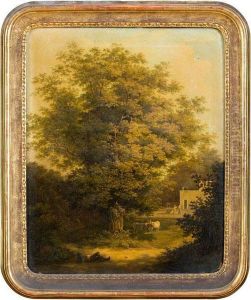Alessandro Fergola Paintings
Alessandro Fergola was an Italian artist, primarily recognized for his contributions to the field of painting and scenography during the 19th century. Born in Naples in 1809, Fergola emerged from a culturally rich background that profoundly influenced his career trajectory. He was part of the vibrant Neapolitan art scene, which was known for its dynamic approach to both classical and contemporary themes. His works encompass a variety of subjects, including historical scenes, landscapes, and architectural views, showcasing his versatility and keen eye for detail.
Fergola's education and artistic training were rooted in the traditions of the Neapolitan school, which emphasized the importance of drawing from life and studying the works of past masters. He was particularly influenced by the luminous landscapes of Salvator Rosa and the dramatic compositions of Luca Giordano. However, Fergola managed to carve out a unique niche for himself by incorporating a distinctive blend of realism and romanticism, capturing the essence of his subjects with both accuracy and emotional depth.
Throughout his career, Alessandro Fergola also made significant contributions to the world of scenography, designing intricate sets for various theaters in Naples. His work in this field was celebrated for its imaginative qualities and its ability to enhance the theatrical experience. Fergola's ability to create compelling visual narratives, whether on canvas or through stage design, earned him accolades and recognition among his contemporaries.
Fergola's legacy is preserved through his artworks, which continue to be appreciated for their historical value and artistic merit. His paintings are held in various collections and museums, serving as a testament to his skill and creativity. Alessandro Fergola passed away in 1884, leaving behind a body of work that continues to inspire and captivate art enthusiasts and historians alike.

